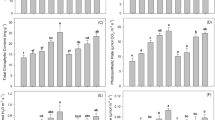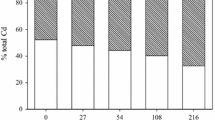Abstract
Compost (mainly composed of cow manure, horse manure, chicken manure, and straw) has turned out to be effective in remediation of heavy metal-contaminated soil. However, in recent years, the effects of green waste compost (GWC) on plant growth and the immobilization of heavy metal cadmium (Cd) in the soil have not been clearly studied. We considered the effects of different GWC ratios on the growth of pakchoi cabbage, soil physical and chemical properties, total and availability of Cd content, and soil enzyme activity. The results showed that organic matter, total nitrogen, available phosphorus, and available potassium in the soil gradually put in place over the increase of compost proportion and showed a significant difference. Dehydrogenase, urease, and catalase activities grew by 380, 35, and 32% under the treatment of T10, respectively. The increase of enzyme activity indirectly reflects the enhancement of self-purification ability of contaminated soil. The addition of GWC improved soil quality, leading to a significant increase in soil nutrients, and in biomass and chlorophyll content of pakchoi cabbage. The decrease of Cd availability led to a significant reduction of Cd content in pakchoi cabbage, with a 30–36% reduction of Cd content in roots and a 43–69% reduction in leaf. The BCF of leaves decreased from 0.62 to 0.22, and the TF decreased from 0.94 to 0.46, indicating that the addition of GWC reduced the mobility of Cd to pakchoi cabbage leaves. The result is decreased in Cd content in edible parts of pakchoi cabbage.



Similar content being viewed by others
References
Alamgir M, Mcneill A, Tang C, Marschner P (2012) Changes in soil P pools during legume residue decomposition. Soil Biol Biochem 49:70–77
Ali A, Guo D, Zhang Y, Sun X, Jiang S, Guo Z, Huang H, Liang W, Li R, Zhang Z (2017) Using bamboo biochar with compost for the stabilization and phytotoxicity reduction of heavy metals in mine-contaminated soils of China. Sci Rep 7:2690
Beesley L, Inneh OS, Norton GJ, Moreno-Jimenez E, Pardo T, Clemente R, Dawson JJC (2014) Assessing the influence of compost and biochar amendments on the mobility and toxicity of metals and arsenic in a naturally contaminated mine soil. Environ Pollut 186:195–202
Bolan NS, Adriano DC, Mani PA, Duraisamy A (2003) Immobilization and phytoavailability of cadmium in variable charge soils. II. Effect of lime addition. Plant Soil 251:187–198
Cao N, Chen X, Cui Z (2012) Change in soil available phosphorus in relation to the phosphorus budget in China. Nutr Cycl Agroecosyst 94:161–170
Chaperon S, Sauvé S (2007) Toxicity interaction of metals (Ag, Cu, Hg, Zn) to urease and dehydrogenase activities in soils. Soil Biol Biochem 39:2329–2338
Critto A, Torresan S, Semenzin E, Giove S, Mesman M, Schouten AJ, Rutgers M, Marcomini A (2007) Development of a site-specific ecological risk assessment for contaminated sites. Part I. A multi-criteria based system for the selection of ecotoxicological tests and ecological observations. Sci Total Environ 379:16–33
Cui H, Zhou J, Si Y, Mao J, Fang G, Liang J (2013) Fractions of cu, Cd, and enzyme activities in a contaminated soil as affected by applications of micro- and nanohydroxyapatite. J Soils Sediments 13:742–752
Dan-Lian H, Guang-Ming Z, Chong-Ling F, Shuang H, Xiao-Yun J, Lin T, Feng-Feng S, Yu Z, Wei Z, Hong-Liang L (2008) Degradation of lead-contaminated lignocellulosic waste by Phanerochaete chrysosporium and the reduction of lead toxicity. Environ Sci Technol 42:4946–4951
Friesl W, Friedl J, Platzer K, ., Horak O, Gerzabek MH (2006): Remediation of contaminated agricultural soils near a former Pb/Zn smelter in Austria: batch, pot and field experiments. Environ Pollut 144, 40–50
Garau G, Castaldi P, Santona L, Deiana P, Melis P (2007) Influence of red mud, zeolite and lime on heavy metal immobilization, culturable heterotrophic microbial populations and enzyme activities in a contaminated soil. Geoderma 142:47–57
Gong X, Li S, Sun X, Li W, Cai L, Zhang J, Le W (2018) Green waste compost and vermicompost as peat substitutes in growing media for geranium (Pelargonium zonale L.) and calendula (Calendula officinalis L.). Sci Hortic 236:186–191
Har-Peled S, Sharir M, Varadarajan KR (2015) The effects of biochar and compost amendments on copper immobilization and soil microorganisms in a temperate vineyard. Agric Ecosyst Environ 201:58–69
Jin HP, Choppala GK, Bolan NS, Chung JW, Chuasavathi T (2011a) Biochar reduces the bioavailability and phytotoxicity of heavy metals. Plant Soil 348:439–451
Jin HP, Lamb D, Paneerselvam P, Choppala G, Bolan N, Chung JW (2011b) Role of organic amendments on enhanced bioremediation of heavy metal(loid) contaminated soils. J Hazard Mater 185:549–574
Jin C, Nan Z, Wang H, Jin P (2017) Plant growth and heavy metal bioavailability changes in a loess subsoil amended with municipal sludge compost. J Soils Sediments 17:1–13
Karami N, Clemente R, Moreno-Jimnez E, Lepp NW, Beesley L (2011) Efficiency of green waste compost and biochar soil amendments for reducing lead and copper mobility and uptake to ryegrass. J Hazard Mater 191:41–48
Khadem A, Raiesi F (2017) Influence of biochar on potential enzyme activities in two calcareous soils of contrasting texture. Geoderma 308:149–158
Khan MD, Mei L, Ali B, Chen Y, Cheng X, Zhu SJ (2013) Cadmium-induced upregulation of lipid peroxidation and reactive oxygen species caused physiological, biochemical, and ultrastructural changes in upland cotton seedlings. Biomed Res Int 2013:1–10
Kim HS, Kim KR, Kim HJ, Yoon JH, Yang JE, Ok YS, Owens G, Kim KH (2015) Effect of biochar on heavy metal immobilization and uptake by lettuce (Lactuca sativa L.) in agricultural soil. Environ Earth Sci 74:1249–1259
Kloss S, Zehetner F, Oburger E, Buecker J, Kitzler B, Wenzel WW, Wimmer B, Soja G (2014) Trace element concentrations in leachates and mustard plant tissue (Sinapis alba L.) after biochar application to temperate soils. Sci Total Environ 481:498–508
Kouping LU, Yang X, Shen J, Robinson B, Huang H, Liu D, Bolan PJ (2014) Effect of bamboo and rice straw biochars on the bioavailability of Cd, Cu, Pb and Zn to Sedum plumbizincicola. Agric Ecosyst Environ 191:124–132
Lebrun JD, Trinsoutrot-Gattin I, Vinceslas-Akpa M, Bailleul C, Brault A, Mougin C, Laval K (2012) Assessing impacts of copper on soil enzyme activities in regard to their natural spatiotemporal variation under long-term different land uses. Soil Biol Biochem 49:150–156
Li Z (2014) A review of soil heavy metal pollution from mines in China: pollution and health risk assessment. Sci Total Environ 468-469:843–853
Li S, Chen J, Islam E, Wang Y, Wu J, Ye Z, Yan W, Peng D, Liu D (2016) Cadmium-induced oxidative stress, response of antioxidants and detection of intracellular cadmium in organs of moso bamboo (Phyllostachys pubescens) seedlings. Chemosphere 153:107–114
Luo XS, Shen Y, Li XD (2012) The mobility, bioavailability, and human bioaccessibility of trace metals in urban soils of Hong Kong. Appl Geochem 27:995–1004
Mohamed I, Zhang GS, Li ZG, Liu Y, Chen F, Dai K (2015) Ecological restoration of an acidic Cd contaminated soil using bamboo biochar application. Ecol Eng 84:67–76
Nie C, Yang X, Niazi NK, Xu X, Wen Y, Rinklebe J, Yong SO, Xu S, Wang H (2018) Impact of sugarcane bagasse-derived biochar on heavy metal availability and microbial activity: a field study. Chemosphere 200:274–282
Paradelo R, Villada A, Barral MT (2011) Reduction of the short-term availability of copper, lead and zinc in a contaminated soil amended with municipal solid waste compost. J Hazard Mater 188:98–104
Rees F, Simonnot MO, Morel JL (2014) Short-term effects of biochar on soil heavy metal mobility are controlled by intra-particle diffusion and soil pH increase. Eur J Soil Sci 65:149–161
Shaheen SM, Rinklebe J (2015) Impact of emerging and low cost alternative amendments on the (im)mobilization and phytoavailability of Cd and Pb in a contaminated floodplain soil. Ecol Eng 74:319–326
Shaheen SM, Tsadilas CD, Rinklebe J (2013) A review of the distribution coefficients of trace elements in soils: influence of sorption system, element characteristics, and soil colloidal properties. Adv Colloid Interf Sci 201-202:43–56
Sims AL, Windels CE, Bradley CA (2010) Content and potential availability of selected nutrients in field-applied sugar beet factory lime. Commun Soil Sci Plant Anal 41:438–453
Singh J, Kalamdhad AS (2013) Effects of lime on bioavailability and leachability of heavy metals during agitated pile composting of water hyacinth. Bioresour Technol 138:148–155
Walker DJ, Clemente R, Bernal MP (2004) Contrasting effects of manure and compost on soil pH, heavy metal availability and growth of Chenopodium album L. in a soil contaminated by pyritic mine waste. Chemosphere 57:215–224
Wang B, Liu GB, Xue S, Zhu B (2011) Changes in soil physico-chemical and microbiological properties during natural succession on abandoned farmland in the Loess Plateau. Environ Earth Sci 62:915–925
Wang Y, Xu Y, Li D, Tang B, Man S, Jia Y, Xu H (2017) Vermicompost and biochar as bio-conditioners to immobilize heavy metal and improve soil fertility on cadmium contaminated soil under acid rain stress. Sci Total Environ 621:1057
William H, Lepp NW (2008) Remediation of arsenic contaminated soils by iron-oxide application, evaluated in terms of plant productivity, arsenic and phytotoxic metal uptake. Sci Total Environ 390:35–44
Xinde C, Lena M, Yuan L, Bin G, Willie H (2011) Simultaneous immobilization of lead and atrazine in contaminated soils using dairy-manure biochar. Environ Sci Technol 45:4884–4889
Yang X, Liu J, Mcgrouther K, Huang H, Lu K, Guo X, He L, Lin X, Che L, Ye Z (2016) Effect of biochar on the extractability of heavy metals (Cd, Cu, Pb, and Zn) and enzyme activity in soil. Environ Sci Pollut Res 23:974–984
Zeng F, Ali S, Zhang H, Ouyang Y, Qiu B, Wu F, Zhang G (2011) The influence of pH and organic matter content in paddy soil on heavy metal availability and their uptake by rice plants. Environ Pollut 159:84–91
Zhang L, Sun X (2016) Influence of bulking agents on physical, chemical, and microbiological properties during the two-stage composting of green waste. Waste Manag 48:115–126
Zhao X, Wang JW, Xu HJ, Zhou CJ, Wang SQ, Xing GX (2015) Effects of crop-straw biochar on crop growth and soil fertility over a wheat-millet rotation in soils of China. Soil Use Manag 30:311–319
Zheng RL, Cai C, Liang JH, Huang Q, Chen Z, Huang YZ, Arp HPH, Sun GX (2012) The effects of biochars from rice residue on the formation of iron plaque and the accumulation of Cd, Zn, Pb, As in rice (Oryza sativa L.) seedlings. Chemosphere 89:856–862
Funding
This work was supported by the National Basic Science and Technology Project (2014FY120700) and Beijing Municipal Science and Technology Project (Z161100001316004). We gratefully acknowledge the Beijing Municipal Education Commission for their financial support through Innovative Transdisciplinary Program "Ecological Restoration Engineering".
Author information
Authors and Affiliations
Corresponding author
Additional information
Responsible editor: Zhihong Xu
Publisher’s note
Springer Nature remains neutral with regard to jurisdictional claims in published maps and institutional affiliations.
Highlights
• Green waste compost (GWC) enhancing the soil fertility, improving soil properties, and improving pakchoi cabbage growth.
• GWC was effective in decreasing available cadmium (Cd) contents in soil.
• Mobility and bioavailability of Cd in the soil-plant system were reduced after GWC application.
• The increase of enzyme activity reflects the enhancement of self-purification ability of contaminated soil.
Rights and permissions
About this article
Cite this article
Li, S., Sun, X., Liu, Y. et al. Remediation of Cd-contaminated soils by GWC application, evaluated in terms of Cd immobilization, enzyme activities, and pakchoi cabbage uptake. Environ Sci Pollut Res 27, 9979–9986 (2020). https://doi.org/10.1007/s11356-019-07533-5
Received:
Accepted:
Published:
Issue Date:
DOI: https://doi.org/10.1007/s11356-019-07533-5




